Assessment of Hybrid Renewable Energy System: A Particle Swarm Optimization Approach to Power Demand Profile and Generation Management
Abstract
1. Introduction
2. Methodology
2.1. Components Formulation
2.1.1. Wind Energy System
2.1.2. Solar Photovoltaic System
2.1.3. Battery Bank System
2.1.4. Diesel Generators System
2.1.5. Power Converter System
2.2. Objectives and Constraints Formulation
2.2.1. Loss of Power Supply Probability
2.2.2. Renewable Factor
2.2.3. Life Cycle Assessment
2.2.4. Jobs Creation
2.2.5. Levelized Cost of Energy
2.2.6. Technology Specifications
2.3. Energy Management System
- When the electricity generated by renewable systems (, ) is sufficient to meet demand, surplus is used to charge the battery bank.
- If the electrical energy generated by renewable systems is capable of meeting electrical demand and the battery bank has already reached its maximum charge, the excess will be discharged into the dump load.
- When demand exceeds the renewable generation capacity, the battery bank will supply the deficit.
- If the electricity demand exceeds renewable generation and the stored energy of the battery bank, the diesel generator is activated under three conditions:
- –
- If the demand is within the nominal capacity of the diesel generator, it will vary its power as long as the demand is not less than the minimum load percentage defined by the manufacturer (). If demand does not require the generator’s full nominal power, the surplus will be used to charge the battery bank. The diesel genset will shut down if the energy of the battery bank can supply the demand and the is less than ().
- –
- If demand exceeds the generator’s capacity, the battery system will turn on to make up the shortfall if the stored energy is available.
- –
- If the battery bank is fully charged, instead of being less than zero, the diesel genset will shut down.
2.4. Description of the Case Studies
2.4.1. Meteorological Data
2.4.2. Load Demand Profiles
2.5. Particle Swarm Optimisation Algorithm
3. Results and Discussion
3.1. Economic and Technical Analysis of HRES Sizing
3.2. Comparative Analysis
3.2.1. Load Demand Analysis
3.2.2. Resource and Configuration Assessment
4. Conclusions
Author Contributions
Funding
Data Availability Statement
Conflicts of Interest
Appendix A. Flowcharts
Appendix A.1. Energy Management System
Appendix A.2. Particle Swarm Optimization
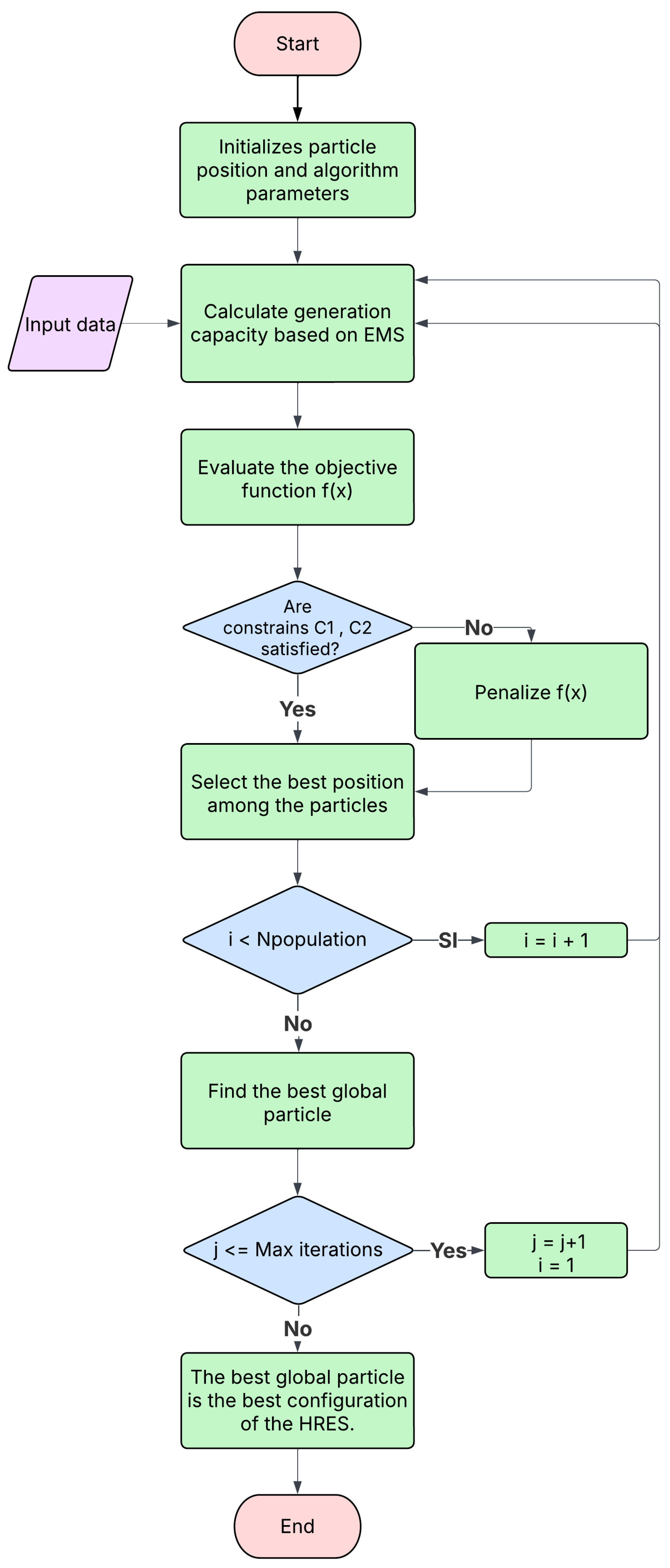
References
- Malheiro, A.; Castro, P.M.; Lima, R.M.; Estanqueiro, A. Integrated sizing and scheduling of wind/PV/diesel/battery isolated systems. Renew. Energy 2015, 83, 646–657. [Google Scholar] [CrossRef]
- Saha, S.; Saini, G.; Mishra, S.; Chauhan, A.; Upadhyay, S. A comprehensive review of techno-socio-enviro-economic parameters, storage technologies, sizing methods and control management for integrated renewable energy system. Sustain. Energy Technol. Assessments 2022, 54, 102849. [Google Scholar] [CrossRef]
- Olabi, A.G.; Elsaid, K.; Obaideen, K.; Abdelkareem, M.A.; Rezk, H.; Wilberforce, T.; Maghrabie, H.M.; Sayed, E.T. Renewable energy systems: Comparisons, challenges and barriers, sustainability indicators, and the contribution to UN sustainable development goals. Int. J. Thermofluids 2023, 20, 100498. [Google Scholar] [CrossRef]
- Energy Institute. Statistical Review of World Energy, 73rd ed.; Energy Institute: London, UK, 2024. [Google Scholar]
- Masinga, F.; Madzivhandila, T. Loadshedding Impact on Food Spoilage: An Analysis of Household Experiences in South Africa. Afr. J. Gov. Dev. 2023, 12, 182–197. [Google Scholar] [CrossRef]
- Adetoro, S.A.; Olatomiwa, L.; Tsado, J.; Dauda, S.M. A comparative analysis of the performance of multiple meta-heuristic algorithms in sizing hybrid energy systems connected to an unreliable grid. E-Prime—Adv. Electr. Eng. Electron. Energy 2023, 4, 100140. [Google Scholar] [CrossRef]
- Ridha, H.M.; Hizam, H.; Mirjalili, S.; Othman, M.L.; Ya’acob, M.E.; Ahmadipour, M.; Ismaeel, N.Q. Multi-objective optimization and multi-criteria decision making aided by numerical method: Framework and a case study of Malaysia and South Africa. Energy Convers. Manag. 2022, 274, 116468. [Google Scholar] [CrossRef]
- Gao, K.; Wang, T.; Han, C.; Xie, J.; Ma, Y.; Peng, R. A Review of Optimization of Microgrid Operation. Energies 2021, 14, 2842. [Google Scholar] [CrossRef]
- Šimunović, J.; Radica, G.; Barbir, F. The effect of components capacity loss on the performance of a hybrid PV/wind/battery/hydrogen stand-alone energy system. Energy Convers. Manag. 2023, 291, 117314. [Google Scholar] [CrossRef]
- Coban, H.H. A multiscale approach to optimize off-grid hybrid renewable energy systems for sustainable rural electrification: Economic evaluation and design. Energy Strategy Rev. 2024, 55, 101527. [Google Scholar] [CrossRef]
- Chauhan, A.; Saini, R. Techno-economic feasibility study on Integrated Renewable Energy System for an isolated community of India. Renew. Sustain. Energy Rev. 2016, 59, 388–405. [Google Scholar] [CrossRef]
- Houssein, E.H.; Ibrahim, I.E.; Kharrich, M.; Kamel, S. An improved marine predators algorithm for the optimal design of hybrid renewable energy systems. Eng. Appl. Artif. Intell. 2022, 110, 104722. [Google Scholar] [CrossRef]
- Tariq, R.; Cetina-Quiñones, A.J.; Cardoso-Fernández, V.; Daniela-Abigail, H.L.; Soberanis, M.A.; Bassam, A.; Lille, M.V.D. Artificial intelligence assisted technoeconomic optimization scenarios of hybrid energy systems for water management of an isolated community. Sustain. Energy Technol. Assessments 2021, 48, 101561. [Google Scholar] [CrossRef]
- Khan, A.; Alghamdi, T.; Khan, Z.; Fatima, A.; Abid, S.; Khalid, A.; Javaid, N. Enhanced Evolutionary Sizing Algorithms for Optimal Sizing of a Stand-Alone PV-WT-Battery Hybrid System. Appl. Sci. 2019, 9, 5197. [Google Scholar] [CrossRef]
- Gonzalez, A.; Riba, J.R.; Esteban, B.; Rius, A. Environmental and cost optimal design of a biomass-Wind-PV electricity generation system. Renew. Energy 2018, 126, 420–430. [Google Scholar] [CrossRef]
- Zhang, Z.; Qin, H.; Li, J.; Liu, Y.; Yao, L.; Wang, Y.; Wang, C.; Pei, S.; Zhou, J. Short-term optimal operation of wind-solar-hydro hybrid system considering uncertainties. Energy Convers. Manag. 2020, 205, 112405. [Google Scholar] [CrossRef]
- Farhat, O.; Khaled, M.; Faraj, J.; Hachem, F.; Taher, R.; Castelain, C. A short recent review on hybrid energy systems: Critical analysis and recommendations. Energy Rep. 2022, 8, 792–802. [Google Scholar] [CrossRef]
- Diab, A.A.Z.; Sultan, H.M.; Kuznetsov, O.N. Optimal sizing of hybrid solar/wind/hydroelectric pumped storage energy system in Egypt based on different meta-heuristic techniques. Environ. Sci. Pollut. Res. 2019, 27, 32318–32340. [Google Scholar] [CrossRef]
- Huang, S.; Wang, L.; Xiong, L.; Zhou, Y.; Gao, F.; Huang, W.; Li, Y.; Guo, H.; Wang, F. Hierarchical Robustness Strategy Combining Model-Free Prediction and Fixed-Time Control for Islanded AC Microgrids. IEEE Trans. Smart Grid 2025, 16, 4380–4394. [Google Scholar] [CrossRef]
- Ibrahim, M.M. Energy management strategies of hybrid renewable energy systems: A review. Wind Eng. 2024, 48, 133–161. [Google Scholar] [CrossRef]
- Thirunavukkarasu, M.; Sawle, Y.; Lala, H. A comprehensive review on optimization of hybrid renewable energy systems using various optimization techniques. Renew. Sustain. Energy Rev. 2023, 176, 113192. [Google Scholar] [CrossRef]
- Bamisile, O.; Cai, D.; Adun, H.; Dagbasi, M.; Ukwuoma, C.; Huang, Q.; Johnson, N.; Bamisile, O. Towards Renewables Development: Review of Optimization Techniques for Energy Storage and Hybrid Renewable Energy Systems. Heliyon 2024, 10, e37482. [Google Scholar] [CrossRef]
- Modu, B.; Abdullah, M.P.; Bukar, A.L.; Hamza, M.F. A systematic review of hybrid renewable energy systems with hydrogen storage: Sizing, optimization, and energy management strategy. Int. J. Hydrogen Energy 2023, 48, 38354–38373. [Google Scholar] [CrossRef]
- HOMER Energy. Available online: https://homerenergy.com/ (accessed on 4 May 2025).
- IHOGA (Instituto de Investigación en Recursos y Agrotecnología). Características. Available online: https://ihoga.unizar.es/caracteristicas/ (accessed on 4 May 2025).
- Natural Resources Canada. RETScreen Clean Energy Management Software; Technical Report; Government of Canada: Ottawa, ON, Canada, 2025. [Google Scholar]
- Hossain Lipu, M.; Rahman, M.A.; Islam, Z.U.; Rahman, T.; Rahman, M.S.; Meraj, S.T.; Hossain, M.Y.; Mansor, M. Review of energy storage integration in off-grid and grid-connected hybrid renewable energy systems: Structures, optimizations, challenges and opportunities. J. Energy Storage 2025, 122, 116629. [Google Scholar] [CrossRef]
- Belboul, Z.; Toual, B.; Kouzou, A.; Mokrani, L.; Bensalem, A.; Kennel, R.; Abdelrahem, M. Multiobjective Optimization of a Hybrid PV/Wind/Battery/Diesel Generator System Integrated in Microgrid: A Case Study in Djelfa, Algeria. Energies 2022, 15, 3579. [Google Scholar] [CrossRef]
- Atawi, I.E.; Abuelrub, A.; Al-Shetwi, A.Q.; Albalawi, O.H. Design of a wind-PV system integrated with a hybrid energy storage system considering economic and reliability assessment. J. Energy Storage 2024, 81, 110405. [Google Scholar] [CrossRef]
- Mohammed, O.H.; Amirat, Y.; Benbouzid, M. Particle Swarm Optimization Of a Hybrid Wind/Tidal/PV/Battery Energy System. Application To a Remote Area In Bretagne, France. Energy Procedia 2019, 162, 87–96. [Google Scholar] [CrossRef]
- Ghorbani, N.; Kasaeian, A.; Toopshekan, A.; Bahrami, L.; Maghami, A. Optimizing a hybrid wind-PV-battery system using GA-PSO and MOPSO for reducing cost and increasing reliability. Energy 2018, 154, 581–591. [Google Scholar] [CrossRef]
- Bilal, M.; Oladigbolu, J.O.; Mujeeb, A.; Al-Turki, Y.A. Cost-effective optimization of on-grid electric vehicle charging systems with integrated renewable energy and energy storage: An economic and reliability analysis. J. Energy Storage 2024, 100, 113170. [Google Scholar] [CrossRef]
- Torres-Madroñero, J.L.; Nieto-Londoño, C.; Sierra-Pérez, J. Hybrid energy systems sizing for the colombian context: A genetic algorithm and particle swarm optimization approach. Energies 2020, 13, 5648. [Google Scholar] [CrossRef]
- Torres-Madroñero, J.L.; Nieto-Londoño, C.; Arenas-Castiblanco, E.; Zapata-Benabithe, Z.; Jouhara, H. Multi-objective optimisation of hybrid renewable energy systems for Colombian non-interconnected zones. Therm. Sci. Eng. Prog. 2024, 55, 102927. [Google Scholar] [CrossRef]
- Salameh, Z. Chapter 1—Factors Promoting Renewable Energy Applications. In Renewable Energy System Design; Salameh, Z., Ed.; Academic Press: Boston, MA, USA, 2014; pp. 1–32. [Google Scholar] [CrossRef]
- Farh, H.M.; Al-Shamma’a, A.A.; Alaql, F.; Omotoso, H.O.; Alfraidi, W.; Mohamed, M.A. Optimization and uncertainty analysis of hybrid energy systems using Monte Carlo simulation integrated with genetic algorithm. Comput. Electr. Eng. 2024, 120, 109833. [Google Scholar] [CrossRef]
- Belfkira, R.; Zhang, L.; Barakat, G. Optimal sizing study of hybrid wind/PV/diesel power generation unit. Sol. Energy 2011, 85, 100–110. [Google Scholar] [CrossRef]
- Ma, X.; Deveci, M.; Yan, J.; Liu, Y. Optimal capacity configuration of wind-photovoltaic-storage hybrid system: A study based on multi-objective optimization and sparrow search algorithm. J. Energy Storage 2024, 85, 110983. [Google Scholar] [CrossRef]
- Teixeira, T.P.; Borges, C.L.T. Operation Strategies for Coordinating Battery Energy Storage with Wind Power Generation and Their Effects on System Reliability. J. Mod. Power Syst. Clean Energy 2021, 9, 190–198. [Google Scholar] [CrossRef]
- Bilal, M.; Bokoro, P.N.; Sharma, G. Hybrid optimization for sustainable design and sizing of standalone microgrids integrating renewable energy, diesel generators, and battery storage with environmental considerations. Results Eng. 2025, 25, 103764. [Google Scholar] [CrossRef]
- Jia, K.; Liu, C.; Li, S.; Jiang, D. Modeling and optimization of a hybrid renewable energy system integrated with gas turbine and energy storage. Energy Convers. Manag. 2023, 279, 116763. [Google Scholar] [CrossRef]
- LG Energy Solution. Battery Glossary—C-Rate (Current Rate). 2022. Available online: https://inside.lgensol.com/en/2022/09/battery-glossary-c-rate-current-rate/ (accessed on 6 May 2025).
- Omotoso, H.O.; Al-Shaalan, A.M.; Farh, H.M.H.; Al-Shamma’a, A.A. Techno-Economic Evaluation of Hybrid Energy Systems Using Artificial Ecosystem-Based Optimization with Demand Side Management. Electronics 2022, 11, 204. [Google Scholar] [CrossRef]
- Borhanazad, H.; Mekhilef, S.; Gounder Ganapathy, V.; Modiri-Delshad, M.; Mirtaheri, A. Optimization of micro-grid system using MOPSO. Renew. Energy 2014, 71, 295–306. [Google Scholar] [CrossRef]
- Mokhtara, C.; Negrou, B.; Settou, N.; Settou, B.; Samy, M.M. Design optimization of off-grid Hybrid Renewable Energy Systems considering the effects of building energy performance and climate change: Case study of Algeria. Energy 2021, 219. [Google Scholar] [CrossRef]
- Nkalo, U.K.; Inya, O.O.; Obi, P.I.; Bola, A.U.; Ewean, D.I. A modified multi-objective particle swarm optimization (M-MOPSO) for optimal sizing of a solar–wind–battery hybrid renewable energy system. Sol. Compass 2024, 12, 100082. [Google Scholar] [CrossRef]
- Ali, A.R.; Bartie, N.; Husmann, J.; Cerdas, F.; Schröder, D.; Herrmann, C. Simulation-based life cycle assessment of secondary materials from recycling of lithium-ion batteries. Resour. Conserv. Recycl. 2024, 202, 107384. [Google Scholar] [CrossRef]
- Mandal, S.; Das, B.K.; Hoque, N. Optimum sizing of a stand-alone hybrid energy system for rural electrification in Bangladesh. J. Clean. Prod. 2018, 200, 12–27. [Google Scholar] [CrossRef]
- National Renewable Energy Laboratory (NREL). Life Cycle Greenhouse Gas Emissions from Electricity Generation: Update; Fact Sheet, NREL/FS-6A50-80580; NREL: Golden, CO, USA, 2020. [CrossRef]
- Dufo-López, R.; Cristóbal-Monreal, I.R.; Yusta, J.M. Optimisation of PV-wind-diesel-battery stand-alone systems to minimise cost and maximise human development index and job creation. Renew. Energy 2016, 94, 280–293. [Google Scholar] [CrossRef]
- Shi, B.; Wu, W.; Yan, L. Size optimization of stand-alone PV/wind/diesel hybrid power generation systems. J. Taiwan Inst. Chem. Eng. 2017, 73, 93–101. [Google Scholar] [CrossRef]
- Wei, M.; Patadia, S.; Kammen, D.M. Putting Renewables and Energy Efficiency to Work: How Many Jobs Can the Clean Energy Industry Generate in the US? Technical Report RAEL Report 2010-01; University of California: Berkeley, CA, USA, 2010. [Google Scholar]
- Sawle, Y.; Gupta, S.; Bohre, A.K. Socio-techno-economic design of hybrid renewable energy system using optimization techniques. Renew. Energy 2018, 119, 459–472. [Google Scholar] [CrossRef]
- Cameron, L.; van der Zwaan, B. Employment factors for wind and solar energy technologies: A literature review. Renew. Sustain. Energy Rev. 2015, 45, 160–172. [Google Scholar] [CrossRef]
- Roy, D.; Zhu, S.; Wang, R.; Mondal, P.; Ling-Chin, J.; Roskilly, A.P. Techno-economic and environmental analyses of hybrid renewable energy systems for a remote location employing machine learning models. Appl. Energy 2024, 361, 122884. [Google Scholar] [CrossRef]
- Kharrich, M.; Kamel, S.; Abdeen, M.; Mohammed, O.H.; Akherraz, M.; Khurshaid, T.; Rhee, S.B. Developed Approach Based on Equilibrium Optimizer for Optimal Design of Hybrid PV/Wind/Diesel/Battery Microgrid in Dakhla, Morocco. IEEE Access 2021, 9, 13655–13670. [Google Scholar] [CrossRef]
- Anand, P.; Rizwan, M.; Bath, S.K. Sizing of renewable energy based hybrid system for rural electrification using grey wolf optimisation approach. IET Energy Syst. Integr. 2019, 1, 227–238. [Google Scholar] [CrossRef]
- Marocco, P.; Ferrero, D.; Lanzini, A.; Santarelli, M. The role of hydrogen in the optimal design of off-grid hybrid renewable energy systems. J. Energy Storage 2022, 46, 103893. [Google Scholar] [CrossRef]
- NASA. POWER Data Access Viewer. Available online: https://power.larc.nasa.gov/data-access-viewer/ (accessed on 15 May 2025).
- Unidad de Planeación Minero Energética (UPME); Instituto de Hidrología, Meteorología y Estudios Ambientales (IDEAM). Atlas de Viento y Energía Eólica de Colombia, 1st ed.; Ministerio de Minas y Energía: Bogotá, Colombia, 2006. [Google Scholar]
- Unidad de Planeación Minero Energética (UPME); Instituto de Hidrología, Meteorología y Estudios Ambientales (IDEAM). Atlas de Radiación Solar de Colombia, 2nd ed.; UPME & IDEAM: Bogotá, Colombia, 2005. [Google Scholar]
- Meier, H.; Fünfgeld, C.; Adam, T.; Schieferdecker, B. Repräsentative VDEW-Lastprofile; Technical Report; Materialien M-32/99; Verband der Elektrizitätswirtschaft (VDEW), BTU Cottbus: Frankfurt am Main, Germany, 1999. [Google Scholar]
- Group Demandlib: Load Profile Generation Library; Version 0.2.2, MIT License. 2025. Available online: https://demandlib.readthedocs.io/en/latest/ (accessed on 30 September 2025).
- Instituto de Planificación y Promoción de Soluciones Energéticas para las Zonas No Interconectadas (IPSE). Informe Mensual de Telemetría: Enero 1–31 de 2024; Informe técnico; Fecha del informe: 20 de febrero de 2024; Centro Nacional de Monitoreo, IPSE: Bogotá, Colombia, 2024. [Google Scholar]
- Clerc, M. Particle Swarm Optimization; First published in France in 2005 by Hermes Science/Lavoisier under the title L’Optimisation par Essaims Particulaires; ISTE Ltd: London, UK; Newport Beach, CA, USA, 2006. [Google Scholar]
- Mohammadi, A.; Sheikholeslam, F. Intelligent optimization: Literature review and state-of-the-art algorithms (1965–2022). Eng. Appl. Artif. Intell. 2023, 126, 106959. [Google Scholar] [CrossRef]
- Rao, S.S. Engineering Optimization: Theory and Practice, 4th ed.; Wiley: Hoboken, NJ, USA, 2009. [Google Scholar]
- Vadi, S.; Bildirici, M.; Kaplan, O. Performance Comparison of Metaheuristic and Hybrid Algorithms Used for Energy Cost Minimization in a Solar–Wind–Battery Microgrid. Sustainability 2025, 17, 8849. [Google Scholar] [CrossRef]
- Prajapati, R.; Dubey, O.P. Analysing the Impact of Penalty Constant on Penalty Function Through Partice Swarm Optimiz ation. Int. J. Stud. Res. Technol. Manag. 2018, 6, 01–06. [Google Scholar] [CrossRef]
- García-Vera, Y.E.; Dufo-López, R.; Bernal-Agustín, J.L. Techno-Economic Feasibility Analysis through Optimization Strategies and Load Shifting in Isolated Hybrid Microgrids with Renewable Energy for the Non-Interconnected Zone (NIZ) of Colombia. Energies 2020, 13, 6146. [Google Scholar] [CrossRef]






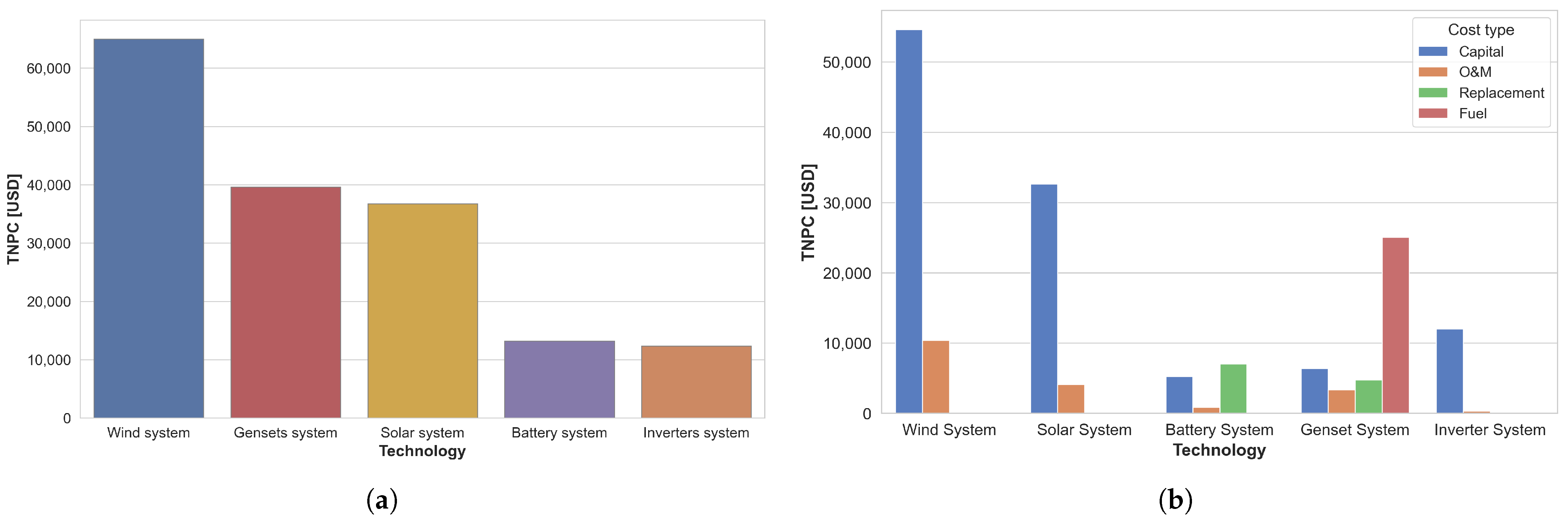
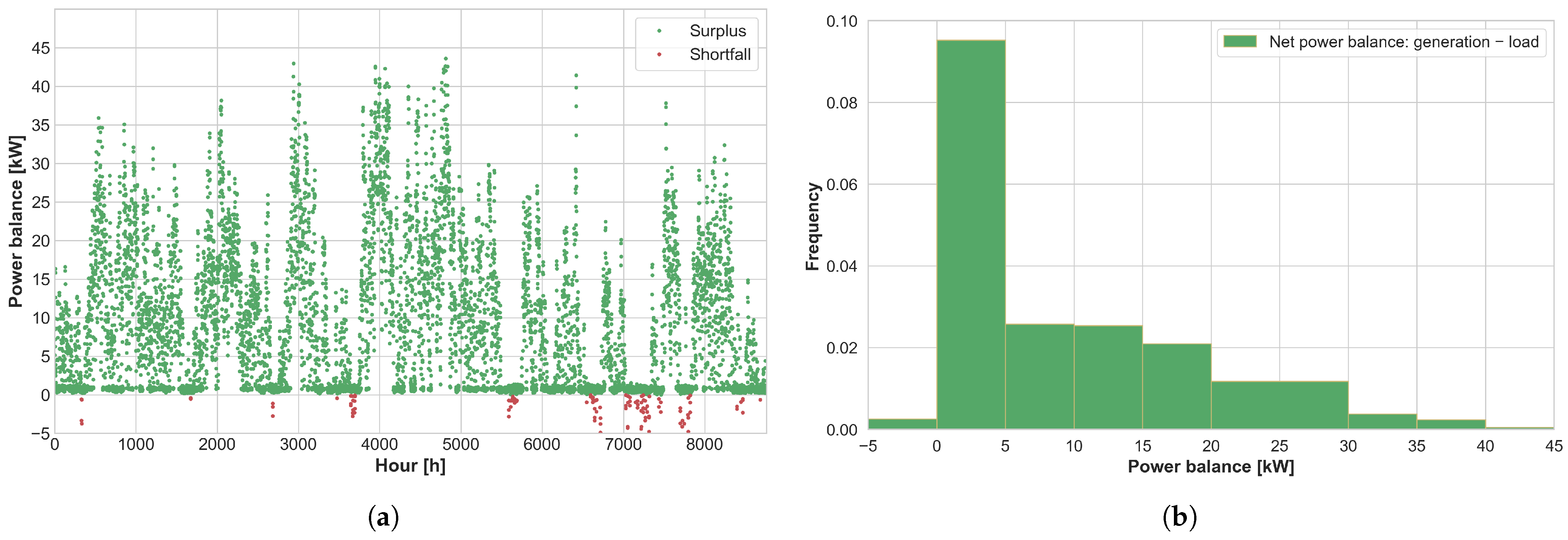
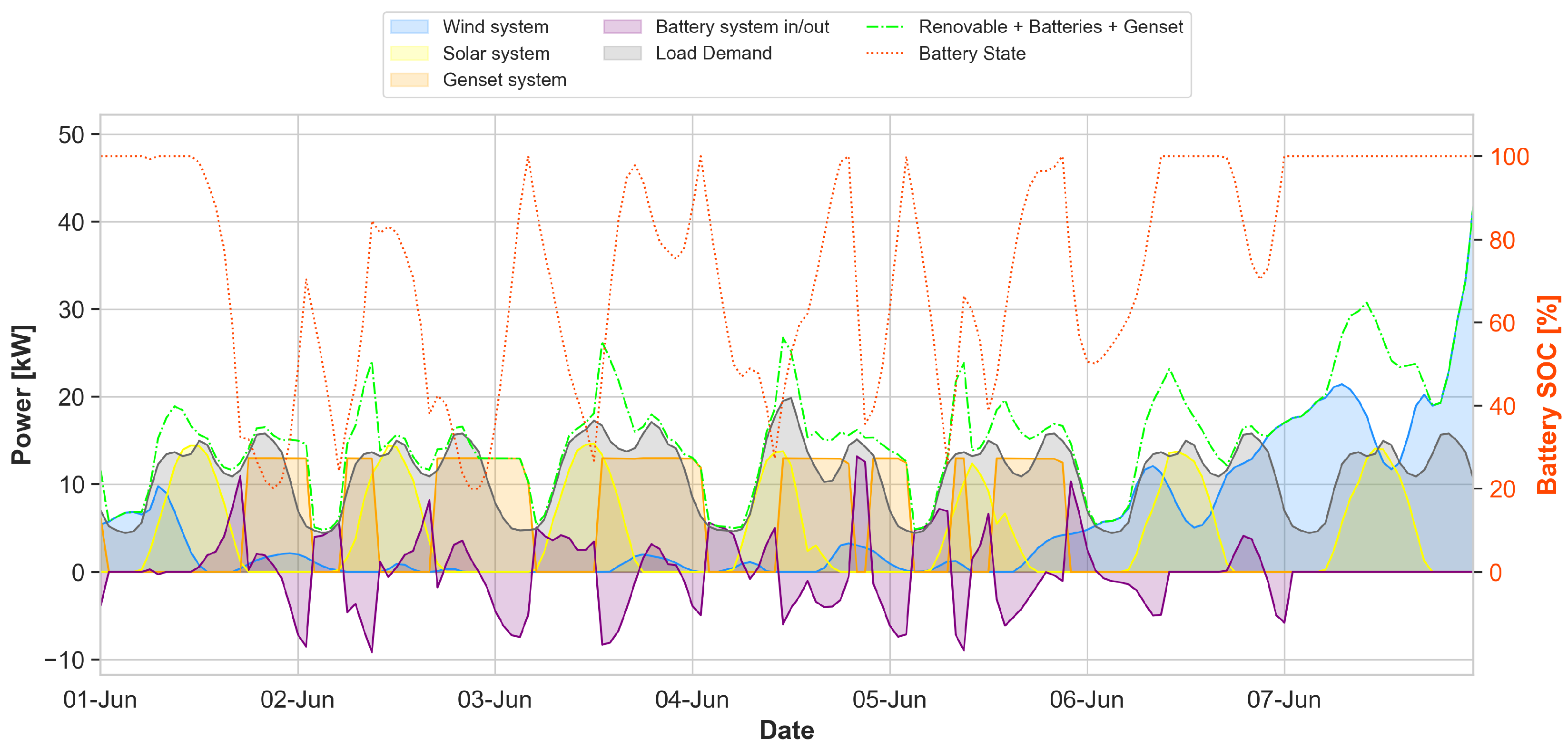

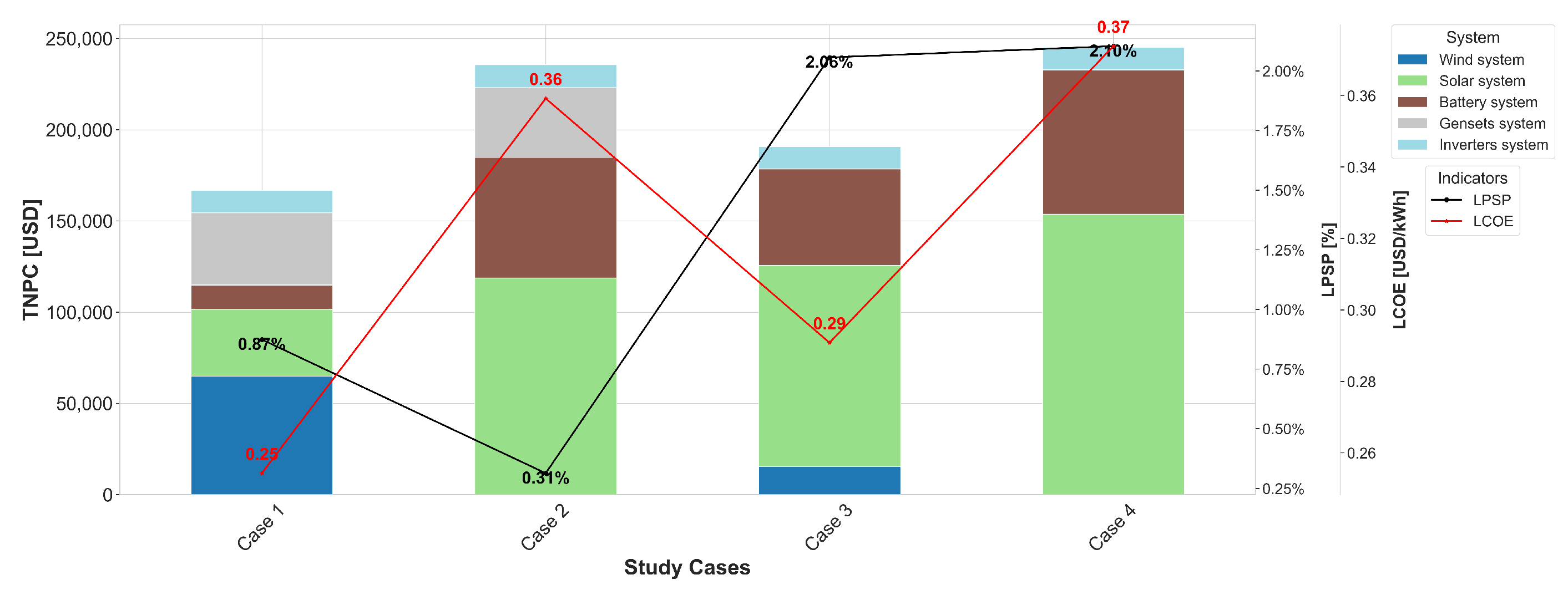



| Description | Parameters | Values | Units |
|---|---|---|---|
| Photovoltaics | 43 | [49] | |
| 2.7 | jobs/MW [50] | ||
| Wind Turbine | 13 | [49] | |
| 1.1 | jobs/MW [50] | ||
| Battery | 33 | [49] | |
| 0.01 | jobs/MWh [50] | ||
| Diesel generator | 840 | [49] | |
| 0.14 | jobs/GWh/year [50] |
| Description | Parameters | Values | Units |
|---|---|---|---|
| Photovoltaics | 465 | W | |
| −0.003 | 1/°C | ||
| 44 | °C | ||
| 1848 | $/kW | ||
| 28.15 | $/kW | ||
| Wind Turbine | 2 | kW | |
| 3 | m/s | ||
| 25 | m/s | ||
| 12 | m/s | ||
| 1300 | $/kW | ||
| 30 | $/kW | ||
| Battery | Lifespan | 5 | Years |
| Rated capacity | 40 | kWh | |
| 95 | % | ||
| 48 | V | ||
| 0.2 | % | ||
| 80 | % | ||
| 132 | $/kWh | ||
| 2.64 | $/kWh | ||
| Inverter | Lifespan | 20 | Years |
| 15 | kW | ||
| 98 | % | ||
| 6000 | $ | ||
| 20 | $/kW | ||
| Diesel generator | Lifespan | 7 | Years |
| Minimum Load | 30 | % | |
| 492 | $/kW | ||
| 0.4 | $/h | ||
| 0.7 | $/L | ||
| Economic parameters | Escalation rate | 2.5 | % |
| Real interest rate | 13.25 | % | |
| Project lifetime | 20 | Years |
| Case | PV | WT | BATT | DG | Load* | Resource | LPSPmax [%] | RF [%] |
|---|---|---|---|---|---|---|---|---|
| 1 | X | X | X | X | Load (1) | La Guajira | 2% | 85% |
| 2 | X | X | X | X | Load (1) | Arauca | 2% | 85% |
| 3 | X | X | X | Load (1) | La Guajira | 2% | 85% | |
| 4 | X | X | X | Load (1) | Arauca | 2% | 85% | |
| 5 | X | X | X | X | Load (2) | La Guajira | 0% | 85% |
| 6 | X | X | X | X | Load (2) | Arauca | 0% | 85% |
| 7 | X | X | X | Load (2) | La Guajira | 0% | 85% | |
| 8 | X | X | X | Load (2) | Arauca | 0% | 85% |
| Case | Load | LCOE | LPSP | RF | LCA | JC | TNPC | |||||
|---|---|---|---|---|---|---|---|---|---|---|---|---|
| 1 | 1 | 21 | 38 | 0.029 | 13 | 1 | 0.2543 | 0.87% | 85% | 14.24 | 0.096 | $166,855.38 |
| 2 | 0 | 123 | 0.514 | 16 | 5 | 0.3592 | 0.31% | 88% | 15.61 | 0.158 | $235,655.61 | |
| 3 | 5 | 114 | 0.445 | 0 | 4 | 0.2908 | 2.06% | 100% | 6.02 | 0.156 | $190,815.43 | |
| 4 | 0 | 159 | 0.674 | 0 | 6 | 0.3738 | 2.10% | 100% | 7.21 | 0.202 | $245,252.19 | |
| 5 | 2 | 69 | 103 | 0.034 | 38 | 1 | 0.2328 | 0.00% | 86% | 42.69 | 0.287 | $467,272.13 |
| 6 | 0 | 368 | 0.645 | 39 | 16 | 0.3483 | 0.00% | 87% | 48.76 | 0.474 | $699,032.89 | |
| 7 | 0 | 511 | 0.945 | 0 | 22 | 0.4097 | 0.25% | 100% | 25.96 | 0.651 | $822,318.53 | |
| 8 | 0 | 529 | 1.122 | 0 | 27 | 0.4447 | 0.22% | 100% | 24.17 | 0.675 | $892,538.92 |
Disclaimer/Publisher’s Note: The statements, opinions and data contained in all publications are solely those of the individual author(s) and contributor(s) and not of MDPI and/or the editor(s). MDPI and/or the editor(s) disclaim responsibility for any injury to people or property resulting from any ideas, methods, instructions or products referred to in the content. |
© 2025 by the authors. Licensee MDPI, Basel, Switzerland. This article is an open access article distributed under the terms and conditions of the Creative Commons Attribution (CC BY) license (https://creativecommons.org/licenses/by/4.0/).
Share and Cite
Turcios, L.J.; Torres-Madroñero, J.L.; Cárdenas, L.M.; Jiménez, M.; Nieto-Londoño, C. Assessment of Hybrid Renewable Energy System: A Particle Swarm Optimization Approach to Power Demand Profile and Generation Management. Energies 2025, 18, 6141. https://doi.org/10.3390/en18236141
Turcios LJ, Torres-Madroñero JL, Cárdenas LM, Jiménez M, Nieto-Londoño C. Assessment of Hybrid Renewable Energy System: A Particle Swarm Optimization Approach to Power Demand Profile and Generation Management. Energies. 2025; 18(23):6141. https://doi.org/10.3390/en18236141
Chicago/Turabian StyleTurcios, Luis José, José Luis Torres-Madroñero, Laura M. Cárdenas, Maritza Jiménez, and César Nieto-Londoño. 2025. "Assessment of Hybrid Renewable Energy System: A Particle Swarm Optimization Approach to Power Demand Profile and Generation Management" Energies 18, no. 23: 6141. https://doi.org/10.3390/en18236141
APA StyleTurcios, L. J., Torres-Madroñero, J. L., Cárdenas, L. M., Jiménez, M., & Nieto-Londoño, C. (2025). Assessment of Hybrid Renewable Energy System: A Particle Swarm Optimization Approach to Power Demand Profile and Generation Management. Energies, 18(23), 6141. https://doi.org/10.3390/en18236141










